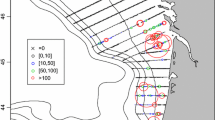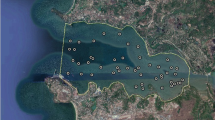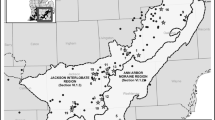Abstract
In this study, two sampling protocols using a model-based and a design-based framework were juxtaposed to evaluate their precision in the estimation of C stock in the Ludikhola watershed, Nepal. The model-based approach exploits the spatial dependencies in the sampled variable and may therefore be attractive over the design-based approach as it reduces the substantial costs of survey and effort required in the latter. Scales of spatial variability for C stock which resulted in a grid resolution of 10,000 m2 were determined using a reconnaissance variogram. Akaike information criterion was used for the selection of the best linear model of feature space for use in kriging with external drift (KED). Among the five tested covariates, distance, elevation, and aspect were statistically significant, with the best model of feature space accounting for 87.7% variability of C stock. An ANOVA established significance differences in mean C stocks (P = 0.00017). KED using the best model of feature space was found to be more precise, (9.89 ± 0.17) sqrt mg C/ha, than a pure-based approach of ordinary kriging and the design-based approach, (9.91 ± 0.8) sqrt mg C/ha. The confidence bounds of the two estimators showed that their confidence intervals will overlap 99.7% of the time, with both confidence intervals falling within the 95% confidence bounds of each other. There is less uncertainty around the mean C stock estimated using the model-based approach than the mean C stock estimated using the design-based approach. The model-based approach is a prospective option for the REDD framework.







Similar content being viewed by others
References
Ahmed, S., & De Marsily, G. (1987). Comparison of geostatistical methods for estimating transmissivity using data on transmissivity and specific capacity. Water Resources Research, 23(9), 1717–1737.
Akaike, H. (1978). A Bayesian analysis of the minimum AIC procedure. Annals of the Institute of Statistical Mathematics, 30, 9–14.
ANSAB. (2010). Forest carbon stock of community forests in three watersheds (Ludikhola, Kayarkhola & Charnawati). In T. G. Capital (Ed.), REDD+ Pilot project (pp. 13–36). Kathmandu: ICIMOD, ANSAB, FECOFUN.
Aydin Coskun, A., & Gençay, G. (2011). Kyoto Protocol and “deforestation”: A legal analysis on Turkish environment and forest legislation. Forest Policy and Economics, 13(5), 366–377.
Baker, D. J., Richards, G., Grainger, A., Gonzalez, P., Brown, S., DeFries, R., et al. (2010). Achieving forest carbon information with higher certainty: A five-part plan. Environmental Science & Policy, 13(3), 249–260.
Basuki, T. M., van Laake, P. E., Skidmore, A. K., & Hussin, Y. A. (2009). Allometric equations for estimating the above-ground biomass in tropical lowland Dipterocarp forests. Forest Ecology and Management, 257(8), 1684–1694.
Berterretche, M., Hudak, A. T., Cohen, W. B., Maiersperger, T. K., Gower, S. T., & Dungan, J. (2005). Comparison of regression and geostatistical methods for mapping Leaf Area Index (LAI) with Landsat ETM+ data over a boreal forest. Remote Sensing of Environment, 96(1), 49–61.
Bhat, D. M., & Ravindranath, N. H. (2011). Above-ground standing biomass and carbon stock dynamics under a varied degree of anthropogenic pressure in tropical rain forests of Uttara Kannada District, Western Ghats, India. Taiwania, 56(2), 85–96
Brown, S. (2002). Measuring carbon in forests: current status and future challenges. Environmental Pollution, 116(3), 363–372.
Bryan, J., Shearman, P., Ash, J., Kirkpatrick, J. B., Hwoor, G. H., Hoodra, R., et al. (2010). Estimating rainforest biomass stocks and carbon loss from deforestation and degradation in Papua New Guinea 1972–2002: Best estimates, uncertainties and research needs. Journal of Environmental Management, 91, 995–1001.
Cambardella, C. A., Moorman, T. B., Novak, J. M., Parkin, T. B., Karlen, D. L., Turco, R. F., et al. (1994). Field-scale variability of soil properties in central Iowa soils. Soil Science Society of America, 58(1), 1501–1511.
Cochran, W. G. (1977). Sampling techniques (3rd ed., pp. 219–222). New York: Wiley.
de Gruijter, J., Brus, D. J., Bierkens, M. F. P., Knotters, M., Hardq, H., Jafroc, K., et al. (2006). Sampling for natural resource monitoring. New York: Springer.
Deutsch, C., & Journel, A. (1998). GSLIB: Geostatistical software library and user’s guide (2nd ed.). New York: Oxford University Press.
Diggle, P. J., & Ribeiro, P. J. (2007). Geostatistical design. In Model-based geostatistics (pp. 199–212). New York: Springer.
Faraway, J. J. (2002). Practical regression and Anova using R. London: CRC Press.
Friedlingstein, P., Cox, P., Betts, R., Bopp, L., von Bloh, W., Brovkin, V., et al. (2006). Climate–carbon cycle feedback analysis: Results from the C4MIP model intercomparison. Journal of Climate, 19(14), 3337–3353.
Gibbs, K. H., Brown, S., & Niles, O. J. (2007). Monitoring and estimating tropical forest carbon stocks: Making REDD a reality. Environmental Research Letters, 2(4), 045023.
Goldstein, H., & Healy, M. J. R. (1995). The graphical presentation of a collection of means. Journal of the Royal Statistical Society: Series A, 158, 175–177.
Goodchild, M. F. (1994). Integrating GIS and remote sensing for vegetation analysis and modeling: methodological issues. Journal of Vegetation Science, 5, 615–626.
Guibal, D. (1973). L’ estimation des oukoumés du Gabon (p. 333). Centre de Morphologie Mathématique, Paris.
Hengl, T. (2007). A practical guide to geostatistical mapping of environmental variables. JRC Technical and Scientific Reports, pp. 120–130.
Houghton, R. A. (2005). Aboveground forest biomass and the global carbon balance. Global Change Biology, 11(6), 945–958.
Hudson, G., & Wackernagel, H. (1994). Mapping temperature using kriging with external drift: Theory and an example from Scotland. International Journal of Climatology, 14, 77–91.
IPCC. (2007). Summary for policy makers. In S. D. Solomon, Q. Manning, Z. Chen, M. Marquis, K. B. Averyt, M. Tignor & H. L. Miller (Eds.), Climate Change 2007: The Physical Science Basis. Contribution of Working Group I to the Fourth Assessment Report of the Intergovernmental Panel on Climate Change. New York: IPCC.
Isaaks, E. H., & Srivastava, R. M. (1989). An introduction to applied geostatistics (p. 561). New York: Oxford University Press.
James, F. C., & McCulloch, C. E. (1990). Multivariate analysis in ecology and systematics: Panacea or Pandora’s box?’. Annual Review of Ecology and Systematics, 21, 129–166.
Keller, M., Palace, M., & Hurtt, G. (2001). Biomass estimation in the Tapajos National Forest, Brazil: Examination of sampling and allometric uncertainties. Forest Ecology and Management, 154(3), 371–382.
Kramer, C. Y. (1956). Extension of multiple range tests to group means with unequal numbers of replications. Biometrics, 12(1), 309–310.
Leemans, R., van Amstel, A., Battjes, C., Kreileman, E., Toet, S., Kwwort, R., et al. (1996). The land cover and carbon cycle consequences of large-scale utilizations of biomass as an energy source. Global Environmental Change, 6(4), 335–357.
Longford, N. T. (2008). ANOVA & ordinary regression. In A. Rizzi & M. Vichi (Eds.), Studying human populations (pp. 1–35). New York: Springer.
MacNally, R. C. (2000). Regression and model-building in conservation biology, biogeography & ecology: The distinction & reconciliation of, predictive & explanatory models. Biodiversity and Conservation, 9, 655–671.
Mansfield, E. R., & Helms, B. P. (1982). Detecting multicollinearity. The American Statistician, 36(3), 158–160.
Montes, F., Hernández, M. J., & Cañellas, I. (2005). A geostatistical approach to cork production sampling estimation in Quercus suber forests. Canadian Journal of Forest Research, 35(12), 2787–2796.
Moore, D., & McCabe, G. (2002). Introduction to the practice of statistics. New York: Freeman.
Odeh, I. O. A., McBratney, A. B., Chittleborough, D. J., & Cadule, P. (1994). Spatial prediction of soil properties from landform attributes derived from a digital elevation model. Geodenna, 63, 197–214.
Oliver, M. A., & Webster, R. (2008). Geostatistics for environmental scientists. Chichester: Wiley.
Rachina, S. (2011). Comparison of individual tree delineation methods for carbon stock estimation using very high resolution satellite images. In Natural resources management (NRM). Enschede: University of Twente (ITC).
Ribeiro, J., & Diggle, P. J. (2001). ‘geoR: A package for geostatistical analysis. R News, 1(2), 15–18.
Sales, H. M., Souza, M. C., Kyriakidis, P. C., Roberts, D. A., Vidal, E., & Valbuena, H. (2007). Improving spatial distribution estimation of forest biomass with geostatistics: A case study for Rondônia, Brazil. Ecological Modelling, 205(1–2), 221–230.
UNFCCC. (1998). Kyoto Protocol to the United Nations framework convention on climate change. Bonn: UNFCCC.
Utset, A., Lopez, T., & Diaz, M. (2000). A comparison of soil maps, kriging and a combined method for spatially prediction bulk density and field capacity of Ferralsols in the Havana-Matanaz Plain. Geoderma, 96(1), 199–213.
Wang, G., Gertner, G. Z., Fang, S., Anderson, A. B., Qi, F., & Xenophorare, T. (2005). A methodology for spatial uncertainty analysis of remote sensing and GIS products. Photogrammetric Engineering & Remote Sensing, 71(12), 1423–1432.
Webster, R., & Oliver, M. A. (1992). Sample adequately to estimate variograms of soil properties. Journal of Soil Science, 43(1), 177–192.
Webster, R., & Oliver, M. A. (2001). Geostatistics for environmental scientists. Chichester: Wiley.
Wells, N. A. (1994). Statistical analysis of circular data: N.I. Fisher, 1993. Cambridge University Press, Cambridge, U.K., (pp. 277). Earth-Science Reviews, 36(4), 249–250.
Wysowski, B. (2010). Mapping and estimation of carbon stock of roadside woody vegetation along roadways in eastern Overijssel, the Netherlands (p. 140). Enschede: University of Twente Faculty of Geo-Information and Earth Observation ITC.
Yan, L., Zhou, S., Ci-fang, W., Hong-yi, L., & Feng, L. (2007). Improved prediction and reduction of sampling density for soil salinity by different geostatistical methods. Agricultural Sciences in China, 6(7), 832–841.
Acknowledgments
The authors wish to thank the Dutch Government (NUFFIC), the International Centre for Integrated Mountain Development (ICIMOD), Asia Network for Sustainable Agriculture and Bio-resources (ANSAB), and the Federation of CF Users Nepal (FECOFUN) for funding this research and the Faculty of Geo-Information Science and Earth Observation (ITC) of the University of Twente for providing a conducive research environment. We thank two anonymous journal reviewers who have helped to improve this manuscript.
Author information
Authors and Affiliations
Corresponding author
Rights and permissions
About this article
Cite this article
Chinembiri, T.S., Bronsveld, M.C., Rossiter, D.G. et al. The Precision of C Stock Estimation in the Ludhikola Watershed Using Model-Based and Design-Based Approaches. Nat Resour Res 22, 297–309 (2013). https://doi.org/10.1007/s11053-013-9216-6
Received:
Accepted:
Published:
Issue Date:
DOI: https://doi.org/10.1007/s11053-013-9216-6




